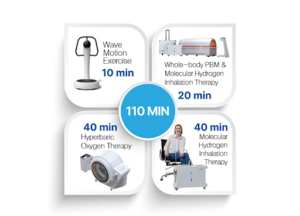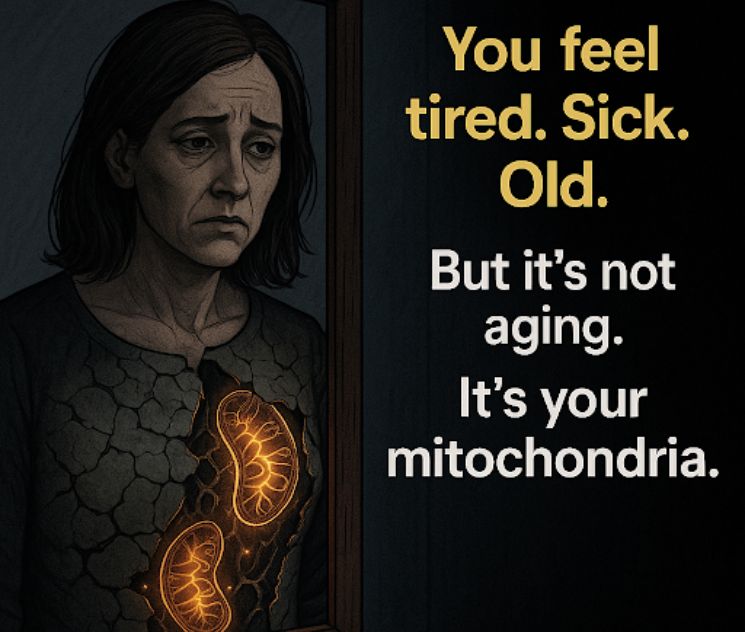Key Takeaways
1. Mitochondrial dysfunction is a primary driver of many chronic diseases, including fatigue, diabetes, dementia, and cardiovascular issues.
2. Damaged mitochondria lead to reduced ATP production, increased oxidative stress, and impaired cellular function.
3. Most conventional treatments manage symptoms but fail to address the root cause at the cellular level.
4. BAHI Therapy offers an innovative, science-backed approach by targeting mitochondrial health to promote lasting recovery.
5. Healing mitochondria and restoring cellular function is the key to reversing chronic illness and achieving long-term wellness.
High blood pressure, diabetes, chronic fatigue, dementia, skin aging…
Where do these chronic conditions truly begin?
We often blame stress, poor diet, or genetics. But if we dig deeper, the root of most chronic diseases leads to one place—your cells, specifically Mitochondria.
Mitochondria are double-membraned organelles present in nearly every human cell, where they play a central role in energy production and maintaining mitochondrial health across the body’s 37 trillion cells. Often referred to as the cell’s “powerhouse,” mitochondria play a critical role in converting oxygen and nutrients into adenosine triphosphate (ATP); the essential energy currency that powers nearly all cellular functions.
However, mitochondria do far more than produce energy. They also help regulate cell death (apoptosis), control oxidative stress, and modulate immune responses. When mitochondria become damaged or dysfunctional, energy production drops, oxidative stress rises, and essential cellular processes begin to fail. The resulting dysfunction can cascade across tissues and organs, contributing to the development of a wide range of chronic health conditions.
According to the 2021 article “Mitochondrial Dysfunction and Metabolic Disease” in Nature Reviews Endocrinology, mitochondrial health is tightly linked to metabolic regulation. When mitochondrial function declines, several critical processes begin to fail:
- Reduced ATP Production: Leads to symptoms like chronic fatigue, muscle weakness, and brain fog.
- Increased Oxidative Stress: Mitochondria are major sources of reactive oxygen species (ROS). When damaged, they produce excess ROS, triggering chronic inflammation and accelerating cellular aging.
- Disrupted Cellular Signaling and Apoptosis: Impaired mitochondria can lead to abnormal insulin secretion in pancreatic beta cells, contributing to type 2 diabetes and blood sugar imbalances.
Related Article: Are Carbohydrates the Root Cause of Chronic Diseases?
What Is Mitochondrial Dysfunction?
Mitochondrial dysfunction refers to a state in which mitochondria lose their ability to produce energy efficiently or perform other essential cellular tasks. This dysfunction can be caused by genetic mutations, environmental toxins, poor nutrition, chronic stress, aging, or a combination of these factors. As a result, cells experience energy shortages, increased oxidative stress, and impaired signaling, all of which disrupt normal cellular operations.
Healthy mitochondria generate ATP through a process called oxidative phosphorylation. When this process breaks down, not only is less energy available to the cell, but more reactive oxygen species (ROS) are produced. These unstable molecules damage cellular structures, including DNA, proteins, and lipids, leading to further mitochondrial injury in a vicious cycle.
How Mitochondrial Dysfunction Triggers Chronic Illness
When mitochondria fail to perform their duties, the consequences ripple throughout the body, often serving as a root cause of many chronic health conditions, including cardiovascular diseases, diabetes, and neurodegenerative disorders.
- Energy Deficiency: Tissues with high energy demands, like the brain, heart, muscles, and pancreas, are the first to suffer. This can lead to chronic fatigue, muscle weakness, and brain fog, which are often early warning signs of more serious conditions.
- Increased Oxidative Stress and Inflammation: Damaged mitochondria produce excess ROS, which contribute to systemic inflammation and tissue degeneration; key drivers in aging, diabetes, cardiovascular disease, and metabolic imbalances.
- Cellular and Metabolic Disruption: In conditions like type 2 diabetes, mitochondrial impairment in pancreatic beta cells reduces insulin secretion. Similarly, in blood vessels, mitochondrial stress impairs nitric oxide availability, contributing to high blood pressure and cardiovascular risk.
- Neurodegeneration: The brain is especially vulnerable to mitochondrial dysfunction due to its high energy demand. Research links mitochondrial damage to cognitive decline, dementia, and neurodegenerative diseases like Alzheimer’s and Parkinson’s.
- Skin Aging and Poor Regeneration: Mitochondrial decline slows collagen production and cellular repair, contributing to visible signs of skin aging, poor wound healing, and overall cellular decline.
In short, mitochondrial dysfunction doesn’t just cause isolated symptoms. It disrupts the body at a fundamental level.
Why Most Chronic Disease Treatments Don’t Work Long-Term
According to the World Health Organization, chronic diseases such as cardiovascular disease, diabetes, and neurodegenerative disorders account for 74% of all global deaths.
Modern medicine has made remarkable advances in managing disease symptoms. Yet, for many chronic conditions such as high blood pressure, type 2 diabetes, fatigue, cognitive decline, long-term relief remains difficult to achieve. Why? Because most treatments are symptom-centric, not cause-centric.
When blood sugar levels rise, the solution is often a glucose-lowering medication. High blood pressure? A daily antihypertensive pill. These interventions can reduce immediate risk, but they often act like putting out smoke without extinguishing the fire. The symptom is masked, but the underlying issue, i.e, mitochondrial dysfunction, remains unresolved.
Mitochondria are at the core of cellular energy, metabolism, and resilience. When they are damaged, the body’s systems begin to fail from the inside out. If a treatment doesn’t address this cellular energy crisis, it merely postpones the problem. Over time, patients may find themselves on multiple medications, still struggling with fatigue, worsening metabolic health, or progressive cognitive decline.
To truly reverse chronic illness, the focus must shift from suppressing symptoms to restoring cellular function, starting with the mitochondria.
Related Article: 3 Proven Ways To Improve Your Mitochondrial Function
How to Reverse Chronic Illness by Healing Cells
It’s time to shift the way we think about chronic disease. True recovery doesn’t begin with suppressing symptoms. It begins by restoring the function of the body’s most fundamental unit: the cell. At the core of nearly every chronic condition lies cellular dysfunction, often driven by damaged mitochondria. The key to lasting health, therefore, is not just managing disease, but revitalizing cellular health.
This is the philosophy behind Huelight’s BAHI Therapy: a comprehensive, integrative system designed to heal the body from the inside out by targeting cellular function across multiple dimensions.
What is BAHI?
BAHI stands for the four foundational pillars of healing:
- Blood Circulation
- Antioxidant Support
- Hormonal Balance
- Immunity Boost

BAHI Therapy combines four advanced therapeutic modalities to address these pillars holistically:
1. Photobiomodulation (PBM)
PBM uses specific wavelengths of red and near-infrared light to stimulate mitochondrial activity. By increasing ATP production, PBM enhances energy availability at the cellular level, reduces inflammation, and relieves pain. Studies show PBM can significantly improve tissue repair, cognitive function, and metabolic health by restoring mitochondrial performance. For a deeper look at how this light-based therapy transforms your cellular health, explore how PBM therapy rewires your cells to fight disease.
2. Hydrogen Inhalation Therapy
This therapy delivers molecular hydrogen gas, a potent antioxidant that selectively neutralizes harmful free radicals like hydroxyl radicals without interfering with beneficial cellular signaling. Clinical research suggests that hydrogen therapy supports neuroprotection, reduces oxidative stress, and enhances overall antioxidant capacity in the body.
3. Hyperbaric Oxygen Therapy (HBOT)
HBOT involves breathing pure oxygen in a pressurized environment, allowing more oxygen to dissolve into the bloodstream. This therapy promotes tissue regeneration, enhances circulation, and supports brain and cardiovascular health. It’s especially effective for wound healing, inflammation reduction, and cognitive recovery(source).
4. Wave Motion Therapy
Through gentle, rhythmic vibrations applied via specialized devices, wave motion therapy stimulates lymphatic flow, reduces muscle stiffness, and improves mobility. It also supports relaxation and sleep quality, which are essential for cellular repair and immune resilience.
By combining these cutting-edge therapies, BAHI Therapy doesn’t just mask symptoms—it targets the root of chronic illness: damaged and energy-depleted cells. The result is a therapeutic approach that empowers the body’s natural healing systems, restores vitality, and offers a path toward long-term wellness.
Application Scenarios for BAHI Therapy
BAHI Therapy is not a one-size-fits-all solution—it is a flexible, multi-modal system designed to address the root causes of a wide range of chronic conditions by restoring mitochondrial function and supporting cellular repair. Below are key application areas where BAHI has shown significant potential:
1. Diabetes & Metabolic Disorders:
Chronic metabolic conditions like type 2 diabetes are marked by insulin resistance, inflammation, and oxidative stress—often driven by mitochondrial dysfunction. BAHI Therapy supports metabolic recovery by:
- PBM: Stimulating ATP production and improving glucose metabolism
- Hydrogen Inhalation: Reducing oxidative stress in pancreatic beta cells
- HBOT: Enhancing oxygen supply and promoting vascular health
Together, these therapies can help restore insulin sensitivity and improve blood sugar regulation.
2. Chronic Fatigue & Sleep Disorders
Fatigue and poor sleep are often signs of impaired cellular energy production. When mitochondria cannot generate adequate ATP, the body struggles to rest and recover. BAHI addresses this through:
- PBM: Boosting mitochondrial energy output
- Wave Motion Therapy: Improving lymphatic circulation, reducing muscle tension, and promoting relaxation
This combination helps recharge the body at the cellular level, leading to deeper, more restorative sleep and sustained energy throughout the day.
3. Parkinson’s, Alzheimer’s & Neurodegenerative Diseases
Neurodegenerative diseases are closely linked to mitochondrial dysfunction and oxidative damage in brain cells.
BAHI offers a multi-targeted approach:
- Hydrogen Inhalation: Selectively neutralizes harmful free radicals to protect neurons (Antioxidants, 2023)
- PBM: Enhances mitochondrial function in brain tissue, supporting memory and cognition
- HBOT: Increases oxygen delivery to the brain, aiding neuroplasticity and healing
Together, these therapies provide neuroprotective effects and may help slow cognitive decline in degenerative conditions.
By targeting disease at the cellular and mitochondrial level, BAHI Therapy provides an innovative, science-backed approach for managing and potentially reversing the progression of many chronic conditions.
Related Article: Alternative Treatments for Chronic Fatigue Syndrome
From Temporary Relief to Lasting Cellular Recovery
Conventional medicine often treats chronic disease like a game of whack-a-mole—targeting symptoms as they surface, without ever addressing their true origin. Fatigue, inflammation, high blood pressure, or insulin resistance are not isolated issues; they are signals of underlying cellular dysfunction, especially within the mitochondria.
BAHI Therapy offers a fundamental shift in approach.
Instead of suppressing symptoms, it supports the body’s innate ability to heal by restoring mitochondrial function and cellular health.
Instead of offering temporary relief, it promotes long-term recovery by addressing the root causes of dysfunction.
Instead of reacting to disease after it takes hold, BAHI fosters proactive, regenerative wellness.
This integrative system—combining Photobiomodulation (PBM), Hydrogen Inhalation, Hyperbaric Oxygen Therapy (HBOT), and Wave Motion Therapy—works synergistically to reverse cellular damage, enhance energy production, and restore physiological balance.
The path to true healing lies not in masking symptoms, but in revitalizing the body at its core: the cell. BAHI Therapy isn’t just a treatment—it’s a roadmap to lasting cellular recovery and renewed vitality.
🔍 Explore More
🔗 Whole-Body PBM Device – Huelight WB-PBM03
🔗 Hyperbaric Oxygen Chambers – View HBOT Series
🔗 Hydrogen Inhalation Device – H-2000 Product Page













